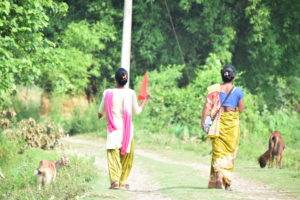Disasters happen when people are exposed to a hazard that they’re unable to cope with.
At Practical Action, we work with communities who are especially vulnerable to disaster risks and develop Early Warning Systems (EWS) that save lives and reduce the impacts of disasters.
- Find out more about our work in early warning systems
What is an Early Warning System?
An effective EWS provides vulnerable communities with the right information, in the right way, and at the right time to prevent disaster.
There is no ‘one size fits all’ solution, and systems must be designed to consider the overlapping contexts of the situation, the hazards and the people involved. For an EWS to be effective it should include four main elements.
- Risk knowledge
- Monitoring and warning
- Dissemination and communication
- Response capability
Risk knowledge
To reduce the risks posed by natural hazards, it’s important to first understand them fully. Risk assessments aim to gather information about where hazards are likely to occur, and which people and assets (like hospitals and main roads) are vulnerable to them.
This knowledge should be shared with those who need it, so that it can be used to inform plans and management strategies. This includes decision makers and officials who are responsible for managing risk, as well as the communities themselves.
Monitoring and warning
Hazard forecasting services must be as locally specific, reliable, accurate, and early as possible. How early a warning can be achieved depends on the hazard. With better scientific methods and tools, and by learning from past warnings, the accuracy of forecasts can keep improving.
A range of government, academic, and local partners must work together to develop and improve forecasting accuracy, accessibility, and affordability.
Dissemination and communication
Warnings must reach the people who need them, in a way they can understand. Methods must be tailored to the receivers and can include a combination of TV and radio announcements, text messages, mobile apps, and in-person dissemination through loudspeakers, sirens, or colour-coded flags. The methods must consider the most marginalised people specifically, including people who lack access to mobile phones and people who cannot read.
Warnings need to be in a language and phrased in a way that people understand. The most useful messages tend to be ones that focus on what the impact of a hazard is likely to be, and what action the recipient should take.
Response Capability
It’s important for people and institutions to have all the knowledge and skills they need to react effectively when a warning is received. Community-based volunteer groups play an important part in this. Roles should be agreed in advance, and regular practice drills should be used to test and improve response capability.
- Watch our video about community led flood drills in Nepal

Cross-cutting themes
Across all these elements, there are four overarching components that are also needed to create effective early warning systems.
Effective governance and institutions
EWS need long-term funding to work well and be sustainable. It also needs to be clear who is responsible for each aspect of the EWS and to what standards these are held.
Where governments lack funds or expertise, it’s possible for the non-profit sector to plug the gaps. In contexts where many stakeholders are involved, coordination and communication are key to make sure the EWS is coherent and sustainable.
Local community involvement
Early warning systems must put people at the centre. Communities aren’t just the receivers of warnings, they also play an important role in developing risk knowledge, data collection, and can share information locally. The active participation of local people, including marginalised groups, ensures EWS can be designed and managed in a way that’s appropriate to that community.
The importance of gender and cultural diversity
Marginalised groups such as people with disabilities, women, indigenous groups and LGBTQIA+ individuals are often the most overlooked by EWS. Effective systems must be developed in gender and socially inclusive ways to ensure that no one is left behind.
- Read about gender transformative early warning systems, and our Missing Voices Approach to inclusion.
A multi-hazard approach
Hazards are complex and often happen simultaneously or trigger each other. Where possible, EWS should be designed to integrate across hazards, in a way that is scalable and can be adapted to any context.

